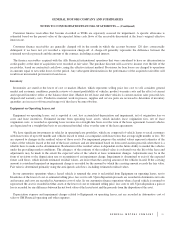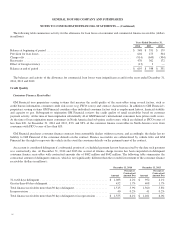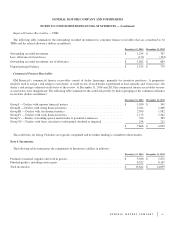General Motors 2014 Annual Report Download - page 75
Download and view the complete annual report
Please find page 75 of the 2014 General Motors annual report below. You can navigate through the pages in the report by either clicking on the pages listed below, or by using the keyword search tool below to find specific information within the annual report.
GENERAL MOTORS COMPANY AND SUBSIDIARIES
NOTES TO CONSOLIDATED FINANCIAL STATEMENTS — (Continued)
Consumer finance receivables that become classified as TDRs are separately assessed for impairment. A specific allowance is
estimated based on the present value of the expected future cash flows of the receivable discounted at the loan’s original effective
interest rate.
Consumer finance receivables are generally charged off in the month in which the account becomes 120 days contractually
delinquent if we have not yet recorded a repossession charge-off. A charge-off generally represents the difference between the
estimated net sales proceeds and the amount of the contract, including accrued interest.
The finance receivables acquired with the Ally Financial international operations that were considered to have no deterioration in
credit quality at the time of acquisition were recorded at fair value. The purchase discount will accrete to income over the life of the
receivables, based on contractual cash flows, using the effective interest method. Provisions for loan losses are charged to operations
in amounts equal to net credit losses for the period. Any subsequent deterioration in the performance of the acquired receivables will
result in an incremental provision for loan losses.
Inventory
Inventories are stated at the lower of cost or market. Market, which represents selling price less cost to sell, considers general
market and economic conditions, periodic reviews of current profitability of vehicles, product warranty costs and the effect of current
and expected incentive offers at the balance sheet date. Market for off-lease and other vehicles is current auction sales proceeds less
disposal and warranty costs. Productive material, work in process, supplies and service parts are reviewed to determine if inventory
quantities are in excess of forecasted usage or if they have become obsolete.
Equipment on Operating Leases, net
Equipment on operating leases, net is reported at cost, less accumulated depreciation and impairment, net of origination fees or
costs and lease incentives. Estimated income from operating lease assets, which includes lease origination fees, net of lease
origination costs, is recorded as operating lease revenue on a straight-line basis over the term of the lease agreement. Leased vehicles
are depreciated on a straight-line basis to an estimated residual value over the term of the lease agreements.
We have significant investments in vehicles in operating lease portfolios, which are composed of vehicle leases to retail customers
with lease terms of up to 60 months and vehicles leased to rental car companies with lease terms that average eight months or less. We
are exposed to changes in the residual values of those assets. For impairment purposes the residual values represent estimates of the
values of the vehicles leased at the end of the lease contracts and are determined based on forecasted auction proceeds when there is a
reliable basis to make such a determination. Realization of the residual values is dependent on the future ability to market the vehicles
under the prevailing market conditions. The adequacy of the estimate of the residual value is evaluated over the life of the lease and
adjustments may be made to the extent the expected value of the vehicle at lease termination changes. Adjustments may be in the
form of revisions to the depreciation rate or recognition of an impairment charge. Impairment is determined to exist if the expected
future cash flows, which include estimated residual values, are lower than the carrying amount of the vehicles leased. If the carrying
amount is considered impaired an impairment charge is recorded for the amount by which the carrying amount exceeds the fair value.
Fair value is determined primarily using the anticipated cash flows, including estimated residual values.
In our automotive operations when a leased vehicle is returned the asset is reclassified from Equipment on operating leases, net to
Inventories at the lower of cost or estimated selling price, less cost to sell. Upon disposition proceeds are recorded in Automotive net sales
and revenue and costs are recorded in Automotive cost of sales. In our automotive finance operations when a leased vehicle is returned or
repossessed the asset is recorded in Other assets at the lower of cost or estimated selling price, less costs to sell. Upon disposition a gain or
loss is recorded for any difference between the net book value of the leased asset and the proceeds from the disposition of the asset.
Depreciation expense and impairment charges related to Equipment on operating leases, net are recorded in Automotive cost of
sales or GM Financial operating and other expenses.
75
























